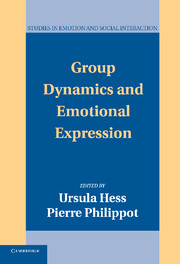Book contents
- Frontmatter
- Contents
- Contributors
- Introduction: The Tale I Read on Your Face Depends on Who I Believe You Are: Introducing How Social Factors Might Influence the Decoder's Interpretation of Facial Expression
- 1 Implications of Ingroup-Outgroup Membership for Interpersonal Perceptions: Faces and Emotion
- 2 When Two Do the Same, It Might Not Mean the Same: The Perception of Emotional Expressions Shown by Men and Women
- 3 It Takes One to Know One Better: Controversy about the Cultural Ingroup Advantage in Communicating Emotion as a Theoretical Rather Than Methodological Issue
- 4 Beauty Is in the Eyes of the Perceiver: The Impact of Affective Stereotyping on the Perception of Outgroup Members' Facial Expressions
- 5 The Perception of Crying in Women and Men: Angry Tears, Sad Tears, and the “Right Way” to Cry
- 6 Tell Me a Story: Emotional Responses to Emotional Expression during Leader “Storytelling”
- 7 Apples and Oranges: Methodological Requirements for Testing a Possible Ingroup Advantage in Emotion Judgments from Facial Expressions
- 8 Others' Faces' Tales: An Integration
- Index
- Cambridge Cultural Social Studies
- References
3 - It Takes One to Know One Better: Controversy about the Cultural Ingroup Advantage in Communicating Emotion as a Theoretical Rather Than Methodological Issue
Published online by Cambridge University Press: 06 August 2009
- Frontmatter
- Contents
- Contributors
- Introduction: The Tale I Read on Your Face Depends on Who I Believe You Are: Introducing How Social Factors Might Influence the Decoder's Interpretation of Facial Expression
- 1 Implications of Ingroup-Outgroup Membership for Interpersonal Perceptions: Faces and Emotion
- 2 When Two Do the Same, It Might Not Mean the Same: The Perception of Emotional Expressions Shown by Men and Women
- 3 It Takes One to Know One Better: Controversy about the Cultural Ingroup Advantage in Communicating Emotion as a Theoretical Rather Than Methodological Issue
- 4 Beauty Is in the Eyes of the Perceiver: The Impact of Affective Stereotyping on the Perception of Outgroup Members' Facial Expressions
- 5 The Perception of Crying in Women and Men: Angry Tears, Sad Tears, and the “Right Way” to Cry
- 6 Tell Me a Story: Emotional Responses to Emotional Expression during Leader “Storytelling”
- 7 Apples and Oranges: Methodological Requirements for Testing a Possible Ingroup Advantage in Emotion Judgments from Facial Expressions
- 8 Others' Faces' Tales: An Integration
- Index
- Cambridge Cultural Social Studies
- References
Summary
Author's Note
This chapter benefited from the helpful comments of Ursula Hess, Abigail Marsh, and Pierre Philippot, as well as from continuing debate with David Matsumoto. I thank Nalini Ambady for her many contributions over the years. Preparation of this chapter was supported by the National Institute of Mental Health Behavioral Science Track Award for Rapid Transition 1R03MH071294-1.
Correspondence can be directed to Hillary Anger Elfenbein at hillary@post.harvard.edu or by post at F-543 Haas School, University of California, Berkeley, CA 94720.
As in many areas within psychology, over time the nature-versus-nurture debate about the expression and perception of emotion has gradually given way to a more balanced perspective arguing for the importance of both nature and nurture – neither to the exclusion of the other. This chapter focuses on one recent and controversial area of research on universals and cultural differences in the communication of emotion: the presence of an ingroup advantage, whereby individuals can more easily and accurately understand emotional expressions originating from members of their own cultural group rather than expressions originating from members of a different cultural group.
There has been controversy about how to interpret empirical findings of the ingroup advantage. Although the controversy has often been framed in terms of a methodological debate about the underlying empirical research (Matsumoto, 2002), close examination of the issue reveals its source to be a subtle yet important theoretical divide (Elfenbein & Ambady, 2002a, 2003b).
- Type
- Chapter
- Information
- Group Dynamics and Emotional Expression , pp. 51 - 68Publisher: Cambridge University PressPrint publication year: 2007
References
- 1
- Cited by



